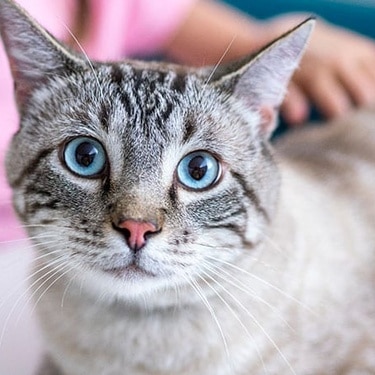
-
Hitta rätt mat för ditt husdjurGör det här testet för att se vilket foder som kan vara bäst för din pälskling.Hitta rätt mat för ditt husdjurGör det här testet för att se vilket foder som kan vara bäst för din pälskling.Utvalda produkter
 Hypoallergenic Adult Hundfoder
Hypoallergenic Adult HundfoderHill's Science Plan Hypoallergenic Adult våtfoder med lax är ett komplett helfoder av högsta kvalitet för alla vuxna hundar från 1 år och uppåt. Detta läckra våtfoder i burk är speciellt sammansatt för hundar med känslig hud och mage. Den innehåller en enda animalisk proteinkälla och är spannmålsfri.
Handla nu Hypoallergeniskt hundfoder för vuxna hundar med lax
Hypoallergeniskt hundfoder för vuxna hundar med laxHILL'S SCIENCE PLAN Hypoallergenic Large Breed Adult hundfoder med lax är ett komplett foder för vuxna hundar av stora raser i åldern 1–5 år. Det är särskilt framtaget för hundar med känslig hud och mage, med begränsade mängder högkvalitativa och nya proteinkällor samt utan spannmål.
Handla nu Healthy Mobility Medium Adult Hundfoder
Healthy Mobility Medium Adult HundfoderHill's Science Plan Healthy Mobility Medium Breed Adult Hundfoder med kyckling erbjuder en avancerad nutrition för att stödja ledhälsa och förbättra rörligheten. provides advanced nutrition to support joint health and improve mobility.
Handla nuHälsotillståndUtvalda produkter Mature Adult Kattfoder
Mature Adult KattfoderHill's Science Plan Adult kattfoder med lax är ett helfoder för äldre katter, speciellt utformat med ActivBiome+ Multi-Benefit teknologi.
Detta foder främjar ett värdigt åldrande hos katter och innehåller en synergistisk blandning av ingredienser som bidrar till att upprätthålla energi- och aktivitetsnivån.Handla nu Hill's Science Plan SENIOR VITALITY KATTFODER Kyckling, med laxHandla nu
Hill's Science Plan SENIOR VITALITY KATTFODER Kyckling, med laxHandla nu Sterilised Kattungefoder
Sterilised KattungefoderHill's SCIENCE PLAN Sterilised Kitten kattungefoder är skapat med Hill´s unika förståelse för de specifika behov som kastrerade kattungar har. Det bidrar med hög proteinkvalitet för muskelutveckling, med kontrollerat fett för att förebygga risk för övervikt efter kastrering. Dessutom har det en unik blandning av antioxidanter för att främja ett hälsosamt immunsystem för att stöjda din kattunges tillväxt.
Handla nu -
Till hundägare
- Tips och artiklar
-
Hälsokategori
- Vikthantering
- Miljö- och foderöverkänslighet
- Urinvägar
- Matsmältning
- Leder
- Njurar
-
Hundens livsstadium
- Näring för valpar
- Näring för vuxna katter
- Näring för seniorer
Till kattägare- Tips och artiklar
-
Hälsokategori
- Vikthantering
- Hud- & foderöverkänslighet
- Urinvägar
- Matsmältning
- Njurar
-
Kattens livsstadium
- Näring för kattungar
- Näring för vuxna
- Näring för seniorer
Utvalda artiklar Virtual Vet Visits: What You Need to Know
Virtual Vet Visits: What You Need to KnowLearn the ins and outs of a televet appointment before you talk to a vet online.
Läs mer Viktförändringar hos hundar och katter - kan det vara ett sköldkörtelproblem?
Viktförändringar hos hundar och katter - kan det vara ett sköldkörtelproblem?En viktförändring kan tyda på ett problem med sköldkörteln. Läs mer om tecken, orsaker och vad du kan göra åt det.
Läs mer Kristaller och stenar i hund- och katturin
Kristaller och stenar i hund- och katturinLäs om orsaker till och behandlingar av kristaller i hund- och katturin för att bibehålla hundens eller kattens hälsa. För expertråd om urinvård, besök Hill's Pet Sverige.
Läs mer -


The government has announced that as of April 2016, all dogs in the UK must be microchipped by law. Many owners don’t necessarily know how microchipping works though and this can lead to the system breaking down, so Hill’s has laid out the facts in one easy reference guide.
The new laws regarding compulsory microchipping for dogs in the UK have been introduced with the hope of reuniting more lost or stolen pets with their owners, reducing the number of stray animals and helping with the prosecution of more owners of dangerous dogs. This is to the delight of organisations such as The Blue Cross, who have been campaigning for such a move for a long time. Laws have also been changed to ensure that dog attacks on private property can no longer automatically go unpunished, encouraging more responsible dog ownership and hopefully reducing UK dog attack statistics.
Authorities such as the The National Dog Warden Association and Dog’s Trust warn that owners need to be aware that microchipping their pet is only the first step towards the system working though. So how does microchipping actually work and what do owners need to do to make sure that their pet is protected in the long-term?
How A Microchip Works
- Each chip is programmed with a unique number that is transmitted when the chip is scanned by a specialised microchip reader.
- This number is associated with the owner’s details in a national database. Because it is a number rather than actual contact details that the chip transmits, any changes to owner details can be made easily and data is protected.
- All vets, council run dog kennels (where strays are taken by a dog warden) and many rescue centres have microchip readers/scanners.
- Regardless of chip manufacturer, all UK readers will scan all UK microchips and the various UK pet owner databases work together to share information when trying to locate a microchipped pets’ owner.
“When our dog Bella went missing and we had heard nothing after a week of desperately trying to find her, we started to lose hope. Then we got a call from a vet saying that they had scanned her microchip after someone had brought her in to them and she was back home within the hour!”
Mr Fairweather, Devon


Tasty Tips
Young pets may need several visits in their first year for vaccinations. Adult pets generally benefit from annual check-ups, while senior or special-needs pets might require more frequent visits.
How A Microchip Is Fitted
- A pre-loaded sterile syringe allows the microchip to be inserted just under the skin, between the shoulder blades.
- Insertion is a quick and straightforward procedure that does not require an anaesthetic.
- Insertion can be performed from as young as one day old.
- The insertion procedure is no more painful than a usual vaccination injection and rarely bleeds. If there is any bleeding, it can be stopped quickly by applying a little pressure.
- Microchips are coated in a special type of glass identical to that used in human pacemakers, so the dog’s body does not try to reject it.
“I was really worried about having Scooby microchipped as a puppy because he was so small. He didn’t bat an eyelid though and was more interested in eating a treat and sniffing the table whilst it was inserted! It’s now been in there for five years with no problems.”
Mrs Francis, Surrey
Making Sure A Microchip Stays Effective
- Microchips only work if the contact details associated with the unique chip number are kept up to date by owners. This is usually done by simply phoning the microchip database company – check any microchip paperwork or ask your vet for details.
- Microchips can sometimes move from where they were originally inserted and (rarely) even come out altogether (usually soon after insertion). Very rarely, they stop working entirely, so regular checks are important. Annual vaccinations are a good time to do this, but ‘chip checks’ can also often be done at the vets without an appointment or charge.
“Owners of microchipped pets must remember to keep their contact details updated. 40% of the dogs we pick up that are chipped have got incomplete or inaccurate data, meaning they can't be returned."
The National Dog Warden Association


En av våra skribenter förberedde den här artikeln åt dig
Relaterade produkter

Hill's Science Plan Healthy Mobility Medium Breed Adult Hundfoder med kyckling erbjuder en avancerad nutrition för att stödja ledhälsa och förbättra rörligheten. provides advanced nutrition to support joint health and improve mobility.

HILL'S SCIENCE PLAN Hypoallergenic Large Breed Adult hundfoder med lax är ett komplett foder för vuxna hundar av stora raser i åldern 1–5 år. Det är särskilt framtaget för hundar med känslig hud och mage, med begränsade mängder högkvalitativa och nya proteinkällor samt utan spannmål.

Hill's Science Plan Hypoallergenic Adult våtfoder med lax är ett komplett helfoder av högsta kvalitet för alla vuxna hundar från 1 år och uppåt. Detta läckra våtfoder i burk är speciellt sammansatt för hundar med känslig hud och mage. Den innehåller en enda animalisk proteinkälla och är spannmålsfri.

Hill's Science Plan Healthy Mobility Large Breed Adult Hundfoder med Kyckling erbjuder en avancerad nutrition för att stödja ledhälsan och förbättra rörligheten.
Relaterade artiklar

Diabetes är en sjukdom som uppstår när blodsockret är för högt. Detta kan orsaka viktökning eller viktminskning hos din katt eller hund.

Läs om orsaker till och behandlingar av kristaller i hund- och katturin för att bibehålla hundens eller kattens hälsa. För expertråd om urinvård, besök Hill's Pet Sverige.

En viktförändring kan tyda på ett problem med sköldkörteln. Läs mer om tecken, orsaker och vad du kan göra åt det.

Learn the ins and outs of a televet appointment before you talk to a vet online.

Sätt din katt eller hund på diet utan att de märker det
Vår kalorifattiga sammansättning hjälper dig att kontrollera din katts eller hunds vikt. Den är fylld med högkvalitativt protein för att bygga slanka muskler och tillverkad med noggrant utvalda ingredienser för en smakrik och näringsrik måltid. Kliniskt bevisade antioxidanter, vitamin C+E, bidrar till ett friskt immunsystem.
Sätt din katt eller hund på diet utan att de märker det
Vår kalorifattiga sammansättning hjälper dig att kontrollera din katts eller hunds vikt. Den är fylld med högkvalitativt protein för att bygga slanka muskler och tillverkad med noggrant utvalda ingredienser för en smakrik och näringsrik måltid. Kliniskt bevisade antioxidanter, vitamin C+E, bidrar till ett friskt immunsystem.

